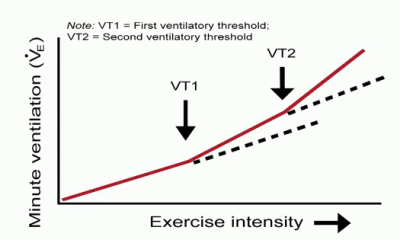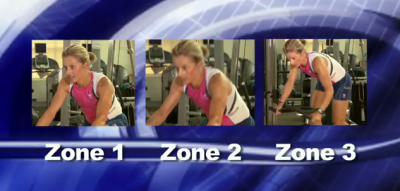
Recommended by ACE - The American Council on Exercise
In Part 1 and Part 2 of Is a 20 Minute Threshold Field Test realistic for your class? I was trying to make the point that although completely appropriate for Endurance Athletes, these 20 minute assessments aren't really appropriate for the typical students in our Indoor Cycling classes.
So if the old 220 - your age is a waste of time, Metabolic Testing is unavailable / too expensive, RPE scales are too subjective and a 20 Minute Field Test isn't practical, what should we use to establish a students Heart Rate Training Zones? And then how do we communicate training intensities in our classes?
I suggest that WE look very strongly at what The American Council on Exercise (ACE) is now recommending with their ACE Integrated Fitness TrainingTM (ACE IFTTM) Model. Follow that link to an exhaustive article on the Two Threshold / Three Zone ACE IFT Model for Cardiorespiratory Training.
Watch this video and then let me know what you think.
A few things that I feel are important to note:
- After watching the video, do you see how you could be conducting a VT1 (Low Threshold) assessment as part of every class you teach?
- This Two Threshold / Three Zone system and the Talk Test method of determining VT1 & VT2 is based on research by Dr. Carl Foster who is presenting at this years conference. Dr. Foster is lecturing on this exact subject 🙂
- The Zoning Blink Heart Rate monitor, with it's Blue - Yellow - Red lights, is based on this same Two Threshold / Three Zone system.


I have spent years trying to persuade participants to get HR monitors or at least chest straps. I have even loaned out chest straps to them so they could use the monitors on the bikes (LeMond RevMaster & Keiser M3). I have tried using power (Keiser M3) as well to guide participants to ‘their’ levels.
Power offers some advantages, but I have learned (and now am reading) that even that isn’t perfect indoors – it is so dependent on the cadence and at what cadence the rider is most efficient.
As an instructor, with drop-in programs, life is so much easier when I forgo the technology and just use the talk test. I have tried using the alphabet – participants thought it was silly and a joke. They didn’t like that. For the past year+ now I have had them measure measure effort by the number of syllables that they can get out comfortably before having to pause. Don’t really know if they are listening, but at least they aren’t laughing at me anymore.
I love it! The concept couldn’t be simpler for the general fitness population that we see! I can’t wait to integrate this 3 zone concept! (Stephen – I do the alphabet as well – I’m sure I’ve been laughed at too but I like the basic concept) I’ll still use the more advanced concepts for my one (!) maybe two people that wear a HR monitor but I’m so glad to see this post. Thanks, as always, ICI!
John,
Good call on posting this.
I’m with Sheila, for the 80 to 90% of or our classes, three zones with easy to assess thresholds makes our lives simpler. And yes I have been laughed at as well. I’ve been changing up the old “can you speak comfortably” with this, “can you maintain this effort for two hours?” (just below low threshold or T1), can you maintain this effort for 20 minutes? (just below high threshold or T2) finally an effort you only think you can do for two minutes (above high threshold T2)
If we can get our students to try (again) heart rate monitors and anchor to a HR or flashing light or power, I believe they will come around and see the value. Not all (some just want to just check their brains at the door) but more.
I use a simple Blink 1 (one button). A quick glance to see what color is blinking. I like to play a game to see how close I come to my thresholds by RPE. Not surprising, some days I hit it very close and on others I miss by quite a bit. But that is the beauty of having the blinking light or the number (HR or power) so that one can manage their effort.
I’m glad to see some pushback on the 20 minute field test for threshold as I’ve always felt that it was not necessarily appropriate for general fitness classes…even those that are devoted and work hard and regularly. That test is very tiring even for conditioned, competitive athletes, much less someone who has to get up the next morning to deal with their commute, their family, and their job. Add to that the fact that you have to repeat it every few months and it just seems impractical.
BUT, I’ve watched the video and read the ACE article twice now and it seems that the thresholds they are establishing are much higher than the ones we’ve all been using. For example, their T2 is at a point where a fit person does not want to speak at all and can’t stay there for more than about a minute. This is well above LT and maximum sustainable power. Maybe it is at VO2 Max, but it seems high even for that.
Their T1 is also well above aerobic, where talking is somewhat uncomfortable and the person being tested cannot speak in full sentences. The standard we have always used is rhythmic breathing, but still able to talk for T1.
So, at this point, it all seems like more noise and confusion to me.
Hi Marsha,
T1 and T2 are very well established thresholds and there isn’t any debate where they occur.
I agree that it is different from what others have have presented in the past.
By what you have written here, it sounds like your confusion maybe in trying to compare it to what you are using currently.
The VT1 and VT2 HRs shown for the model taking the test are exactly the same as mine – derived from multiple Metabolic assessments. I use a different method to find T1 (it’s simply the point where I can no longer breathe exclusively through my nose = need to exhale through my mouth) and I’m pretty confident that I can peg my T1 blindfolded.
Marsha,
I watched the video again and now I see (and agree with your comment) about working above T2. They don’t describe how high above T2 she is, so you are right, they are talking about an intensity quite a bit above T2, not at T2.
I do feel that they accurately portray T1.
We need our own video 🙂
I still feel that their T1 is also too high. Refer back to Tom Scotto’s excellent Riding Your Thresholds profile. T1 is endurance level, well below the beginning of breathlessness. The woman in the video should be able to get out more than 3 words. I think that where she is is roughly an 80% effort on the perceived exertion scale.
Just came upon this article and curious to hear any thoughts on working Aerobically or Anaerobically during these tests. I can sustain 110 RPM’s at 165 BPM’s with heavy breathing for 20 minutes whereas I can only sustain 165 BPM’s at 60 RPM’s with tension without blowing up for maybe 2-4 minutes.